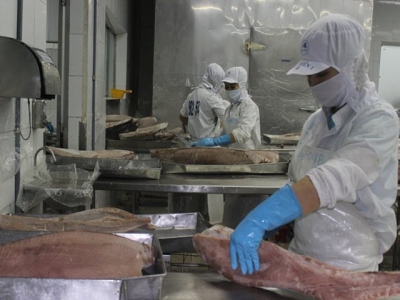Many advantages for tuna exports to ASEAN

Most tariff lines being cut to 0% is a favourable condition to boost Vietnam's tuna exports to ASEAN.
Tuna processing for exports. Photo: T.H
According to the Vietnam Association of Seafood Exporters and Producers (VASEP), ASEAN is one of Vietnam's most important tuna export markets. Vietnam’s tuna export turnover to this market is increasing. In particular, when the ASEAN Trade in Goods Agreement (ATIGA) officially came into effect in 2010, most tariff lines falling to 0% was one of the favourable conditions to boost Vietnam's tuna exports to ASEAN.
ATIGA was created to regulate trade in intra-ASEAN and was built on the basis of synthesising the approved commitments in CEPT and AFTA and related agreements and protocols.
The tariff cuts have created a great opportunity for Vietnam’s tuna exports to this market. Before 2010 when the agreement was not effective, Vietnam’s tuna exports to ASEAN were only US$1.6 - 6 million per year. However, from 2010 onwards, exports to this market gained remarkable growth. In 2010, they rose by 190%, from US$6 million in 2009 to nearly $17.5 million in 2010. And so far, it has increased to more than US$50 million.
In addition, in the long run, ATIGA has an indirect impact on increasing Vietnam’s export turnover to non-ASEAN markets because of importing raw materials for export production with cheaper prices from ASEAN. Also, as a member of ATIGA, Vietnam has conditions to exploit new advantages in trade relations with big countries.
However, the tariff cuts have also created a big challenge for Vietnam’s tuna processing and exporting enterprises. This is because ASEAN is a near market which has similarities in terms of natural conditions and exploitation resources with Vietnam.
Therefore, Vietnam's exported tuna structure with ASEAN countries is quite similar. With the smaller scale and lower development level of the tuna industry, Vietnam struggles to compete with regional countries such as Thailand, the Philippines or Indonesia, as these countries also enjoy benefits similar to Vietnam.
Therefore, Vietnam still has to face fierce competition with other members of the ATIGA, not only in the regional market, but also in the world market.
Có thể bạn quan tâm
 Tra fish exports to Japan skyrocket in four months
Tra fish exports to Japan skyrocket in four months Tra fish exports to Japan leaped by 61.5 per cent on year to reach US$11.54 million in the first four months of the year
 Japan among top 10 importers of Việt Nam’s tra fish for first time
Japan among top 10 importers of Việt Nam’s tra fish for first time Vietnamese tra fish, a major foreign currency earner, has gradually won the trust of Japanese consumers as seen in the market’s emergence
 Việt Nam aquaculture has room to improve
Việt Nam aquaculture has room to improve Việt Nam’s seaculture area is set to reach 270,000ha with expected marine production of 750,000 tonnes by 2020.